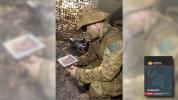Search
Using the filters to the left, click your selection, it will become bold and filter the results, click it again to remove that filter.
The decision by President Biden’s Administration to withdraw from Afghanistan received strong criticism and opposition from many military veterans, former decision makers and policy analysts from Capitol Hill . While the basis for criticism is diverse, one common feature that emerges from the commentary is a strong sense that the US was unable to achieve an integrated civil-military strategy to underpin decision making in Afghanistan , and that the same fault beleaguered operations in Iraq and Syria. The …

The British Army on the Western Front 1917 By Ed Spencer Jones Helion , Warwick, 2022, 514pp, Images: 87 b/w photos, 21 maps 9781914059858 - Paperback Reviewed by BRIG Chris Roberts AM. CSC (Retd.) This is the fourth in the series of splendid books edited by Dr Spencer Jones which provide insights into the British Expeditionary Force (BEF) on the Western Front. Each volume covers a year of the war and this one delivers the same high standards of scholarship as its predecessors. The books’ value lies in …

The Defence of Portugal during the Peninsular War, 1807 – 1814 By Mark S. Thompson Helion , Warwick, 2021, 224pp, Images: 28 colour and 50 b/w illustrations, maps and diagrams 9781914059858 - Paperback Reviewed by BRIG Chris Roberts (Retd.) In this meticulously researched book, Mark Thompson delivers a comprehensive study filled with a wealth of information on the planning, construction, and defence of the Lines of Torres Vedras. Along the way, the author challenges some earlier held views, providing …

Foreword The Australian soldier has a well-earned reputation for expertise in counter-insurgency. Perhaps this reputation is born from Australia’s experience of the Malayan Emergency, the Borneo Confrontation or the Vietnam War; and it was probably sustained through United Nations deployments as peacekeepers within generally fractured societies. Regardless of its genesis, this collection of papers responds to this tradition, by focussing academic inquiry into the irregular form of warfare. Examination of …
Lieutenant Colonel Clarence Hovell is an Australian Army Infantry Officer, a graduate of the Australian Command and Staff College, and formerly the Commanding Officer of Combat Training Centre – Live where he was responsible for improving the performance of Army’s largest teams through immersion in the Decisive Action Training Environment. Lieutenant Colonel Hovell has a Master of Military and Defence Studies from the Australia National University and a Master of Strategy and Security from the University …
By Elliot Ackerman and Admiral James Stavridis Penguin Press , 2021, 303pp ISBN 9781984881267 - Paperback ISBN 9781984881250 - Hardcover ISBN 9781984881267 - Ebook ISBN 9780593394748 - Audio Reviewed by Dr Albert Palazzo In 1978, the retired British general Sir John Hackett published an account of a fictional war between the United States and the Soviet Union . Reading it is a distant memory for me, but at the time it formed a part of my foundation as a scholar of war. The Cold War was ongoing and …

Election-related material is not available on this website. Such material may be found on party political websites. With the announcement of a federal election, the Australian Government is now in a caretaker period. Australian Government resources are not used to communicate political material. More information can be accessed here: Guidance on Caretaker Conventions . … Federal …
The 51st (Highland) Division during the First World War By Craig French Helion , Solihull, 2017, 300pp, Images : 4 maps & 26 tables 9781911096542 - Hardback Reviewed by BRIG Chris Roberts (Retd.) The 51st (Highland) Division earned a high and (from their German opponents) fearsome reputation. Its exploits during the Great War have been the subject of at least four previous histories, the latest being Colin Campbell’s The 51st (Highland ) Division in the Great War: Engine of Destruction , published in 2013, …

What it looks like Tactically, Operationally, and Strategically The author acknowledges the efforts, analysis, and assistance of Commander Jorge McKee and Lieutenant Colonel Uliano Polatos. Both officers significantly contributed to, and directly provided, the ideas and analysis that supports this article. History does not repeat itself, but it rhymes. Attributed to Mark Twain. [Australia’s] strategic culture values engagement with culturally compatible, like-minded worldwide powers, coalitions or …

The content in this article is an extract of Spotlight Brief 7/21 . ResQBot 2.0: An improved Design of a Mobile Rescue Robot with an Inflatable Neck Securing Device for Safe Casualty Extraction Applied Sciences – Jun 2021 The authors of this study propose a novel design for a mobile rescue robot that can extract casualties from dangerous areas. They present ResQbot 2.0 – a stretcher-type robot capable of safely performing extraction through loco-manipulation that is synchronised with a conveyer belt and …


